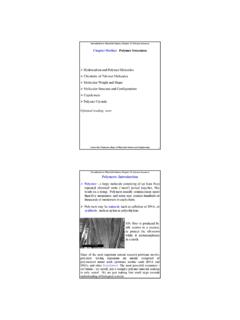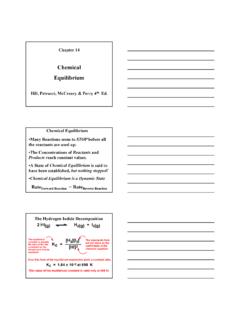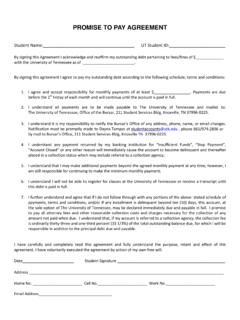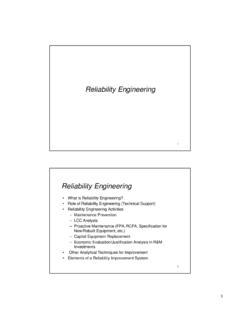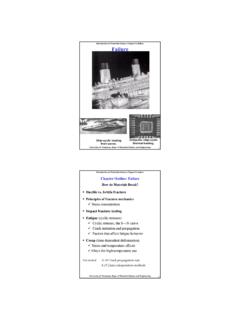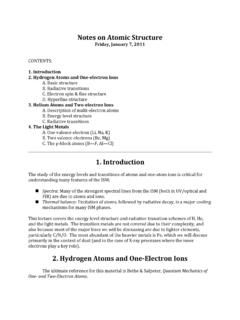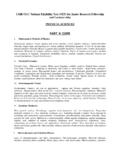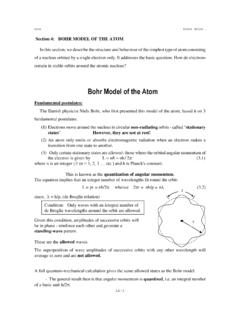Transcription of Chapter 1 Basics
1 Introduction To Materials Science and Engineering, Ch. 1 University of Tennessee, Dept. of Materials Science and Engineering1 Chapter 1 Materials for EngineeringA fly-by during deployment of the aircraft carrier USS Stennis. The pilot was grounded for 30 days, but he likes the picture and thinks it was worth it. Introduction To Materials Science and Engineering, Ch. 1 University of Tennessee, Dept. of Materials Science and Engineering2 Materials Science and Engineering Materials Science Investigating relationships that exist between the structure and properties of materials Materials Engineering Is, on the basis of these structure -property correlations, designing or engineering the structure of a material to produce a pre-determined set of properties Introduction To Materials Science and Engineering, Ch.
2 1 University of Tennessee, Dept. of Materials Science and Engineering3 structure Sub atomic electrons and nuclei (protons and neutrons) atomic organization of atoms or molecules Microscopic groups of atoms that are normally agglomerated together Macroscopic viewable with the un-aided eyeIntroduction To Materials Science and Engineering, Ch. 1 University of Tennessee, Dept. of Materials Science and Engineering4 Terminologymil = 1 / 1000 inch = mmicrometer = 1 / 1,000,000 meter = 1 mAngstrom = 1 / 10,000,000,000 meter = 1 1 MICROMETER IS TWO WAVELENGTHS OF GREEN LIGHT LONGA HAIR IS 100 MICROMETERSA 1 MICRON WIDE LINE ON A CDIS THE SAME SCALE AS A 100 FOOTWIDE ROAD ON NORTH AMERICAI ntroduction To Materials Science and Engineering, Ch.
3 1 University of Tennessee, Dept. of Materials Science and Engineering5 Progress in atomic -level understandingDNA~2 nm wideThings NaturalThings ManmadeTHE SCALE OF THINGS10 nmCell membraneATP synthaseSchematic, central coreCat~ mDust mite300 mMonarch butterfly~ mMEMS (MicroElectroMechanical Systems) Devices10 -100 m wideRed blood cellsPollen grainFly ash~ 10-20 m Bee~ 15 mmAtoms of siliconspacing ~tenths of nmHead of a pin1-2 mmMagnetic domains garnet film11 m wide stripesProgress in miniaturizationIndium arsenidequantum dot Quantum dot array --germanium dots on siliconMicroelectronicsObjects fashioned frommetals, ceramics, glasses, polymers.
4 Human hair~ 50 m wideThe nm1 nanometer (nm) m10 m100 nm1 micrometer ( m) mm10 mm100 m1 millimeter (mm) m1 cm10 m100 mm1 meter (m)100m10-1m10-2m10-3m10-4m10-5m10-6m10- 7m10-8m10-9m10-10mVisiblespectrumThe NanoworldThe 21st century challenge -- Fashion materials at the nanoscale with desired properties and functionalityRed blood cellswith white cell~ 2-5 mIntroduction To Materials Science and Engineering, Ch. 1 University of Tennessee, Dept. of Materials Science and Engineering6 ProcessingStructurePropertiesPerformance Introduction To Materials Science and Engineering, Ch. 1 University of Tennessee, Dept.
5 Of Materials Science and Engineering7ex: hardness vs structure of steel Properties depend onstructureData obtained from Figs. (a)and with 4wt%C composition,and from Fig. and associateddiscussion, Callister adapted from (a) ; (b) Fig. ;(c) Fig. ;and (d) Fig. , Callister : structure vs cooling rate of steel Processing can changestructureStructure, Processing, & PropertiesCooling Rate (C/s) 1000(a)30 m(b)30 m(d)30 m(c)4 mHardness (BHN)Introduction To Materials Science and Engineering, Ch. 1 University of Tennessee, Dept. of Materials Science and ApplicationDetermine required candidate Material(s) required ProcessingProcessing: changes structureand overall shapeex: casting, sintering, vapor deposition, dopingforming, joining, : mechanical, electrical, thermal,magnetic, optical, : structure , Materials Selection ProcessIntroduction To Materials Science and Engineering, Ch.
6 1 University of Tennessee, Dept. of Materials Science and Engineering9 Composition, Bonding, Crystal structure and Microstructure DEFINE Materials PropertiesCompositionBondingCrystal StructureThermomechanicalProcessingMicro structureMechanicalPropertiesElectrical & MagneticPropertiesOptical PropertiesThermal PropertiesIntroduction To Materials Science and Engineering, Ch. 1 University of Tennessee, Dept. of Materials Science and Engineering10T ( C)-200-1000Cu + at%NiCu + at%Nideformed Cu + at%Ni123456 Resistivity, (10-8 Ohm-m)0Cu + at%Ni Pure Cu Electrical Resistivity of Copper: Adding impurity atoms to Cu increases resistivity.
7 DeformingCu increases from Fig. , Callister 6e.(Fig. adapted from: Linde,Ann Physik5, 219 (1932); Wert and Thomson,Physics of Solids, 2nd edition,McGraw-Hill Company, New York,1970.)ELECTRICALI ntroduction To Materials Science and Engineering, Ch. 1 University of Tennessee, Dept. of Materials Science and Engineering11 Magnetic Permeabilityvs. Composition:--Adding 3 atomic % Simakes Fe a betterrecording medium!Magnetic FieldMagnetizationFe+3%SiFeAdapted from Barrett, Nix, Tetelman, The Principles ofEngineering Materials, Fig. 1-7(a), p. 9,1973. Electronically reproducedby permission of Pearson Education, Inc.
8 ,Upper Saddle River, New , Callister 6e.(Fig. is from Lemke, MRS Bulletin,Vol. XV, No. 3, p. 31, 1990.) Magnetic Storage:--Recording mediumis magnetized byrecording To Materials Science and Engineering, Ch. 1 University of Tennessee, Dept. of Materials Science and Engineering12 Transmittance:--Aluminum oxide may be transparent, translucent, oropaque depending on the material structure . Adapted from Fig. ,Callister 6e.(Specimen preparation, Lessing; photo by J. Telford.)single crystalpolycrystal:low porositypolycrystal:high porosityOPTICALI ntroduction To Materials Science and Engineering, Ch.
9 1 University of Tennessee, Dept. of Materials Science and Engineering13 Stress & cracks! Heat treatment:slowscrack speed in salt water! 4 m--material:7150-T651 Al "alloy"(Zn,Cu,Mg,Zr)Adapted from Fig. (b), Hertzberg, "Deformation and Fracture Mechanics of Engineering Materials" (4th ed.), p. 505, John Wiley and Sons, 1996. (Original source: Markus O. Speidel, Brown Boveri Co.)Adapted from Fig. , Callister 6e.(Fig. is from Marine Corrosion, Causes, and Prevention, John Wiley and Sons, Inc., 1975.)Adapted from Fig. ,Callister 6e. (Fig. provided courtesy of and Miller, Boeing CommercialAirplane Company.)
10 Held at 160C for 1hr before testing increasing loadcrack speed (m/s) as-is 10-1010-8 Alloy 7178 tested in saturated aqueous NaCl solution at 23 CDETERIORATIVEI ntroduction To Materials Science and Engineering, Ch. 1 University of Tennessee, Dept. of Materials Science and Engineering14 Types of MaterialsMetals: strong, ductile, tough, high density, : strong, brittle, low density, : weak, ductile, low density, : weak, brittle, low density, : strong, ductile, low density, conductors, : atoms have long range periodic order (a).Glasses: atoms have short range order only (b).(a)(b)Introduction To Materials Science and Engineering, Ch.
